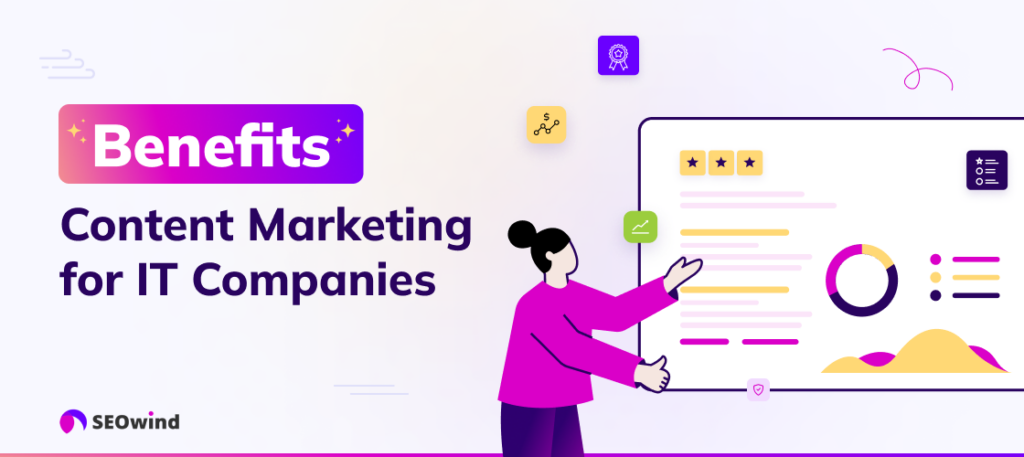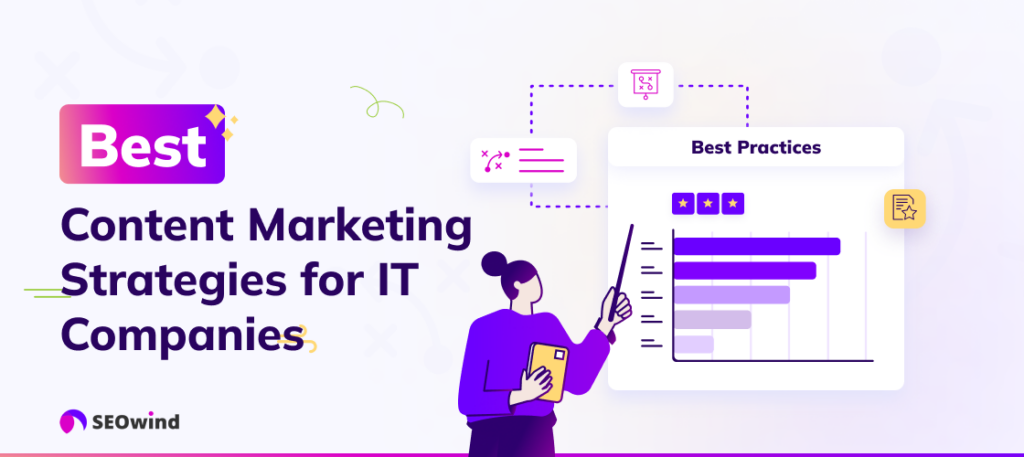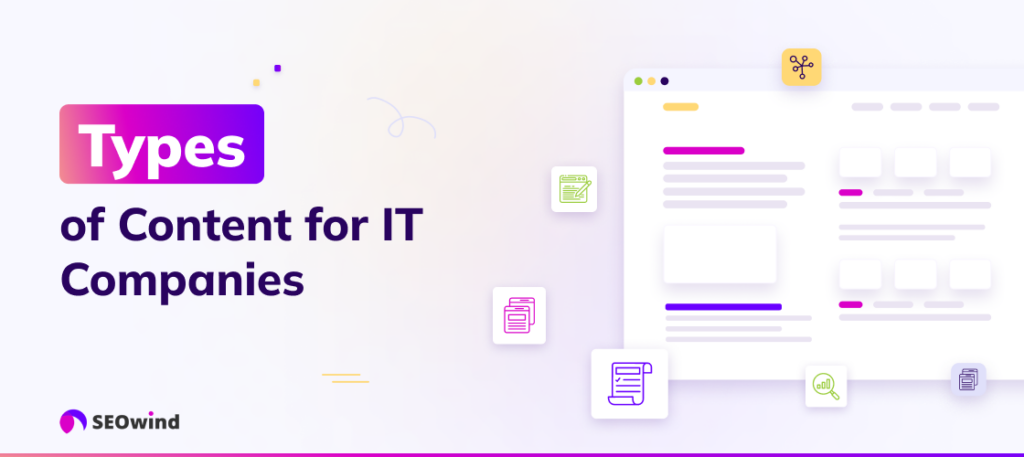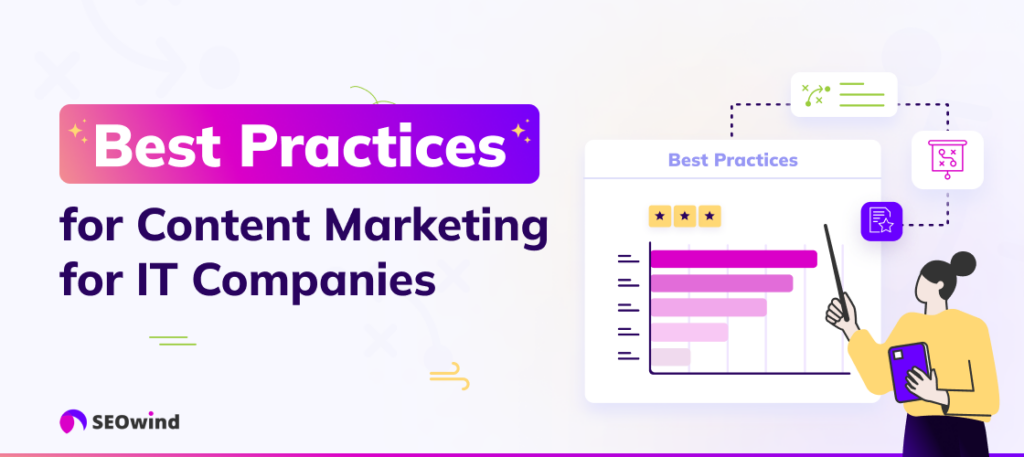In the dynamic landscape of information technology (IT), demonstrating value beyond your tech stack sets you apart from the competition. This is where the power of content marketing steps in, serving as a potent way to communicate with your audience, promote your brand, and generate leads. Dig into this ultimate guide and unlock the keys to mastering content marketing for tech companies.
Introduction to Content Marketing for IT Companies
What is Content Marketing?

Content marketing focuses on creating valuable, relevant, consistent information to attract and retain a clearly defined audience — ultimately leading to profitable customer interactions. It’s not about pitching your products or services. It’s about delivering substance that makes your consumers more enlightened. It shapes up as helpful articles, videos, podcasts, and infographics, among other forms— providing knowledge and practical insights related to their interests or businesses—a powerful fuel driving inbound traffic and engagements.
Benefits of Content Marketing for IT Companies

Unlike traditional advertising practices that often intrude on potential customers’ space unsolicitedly, content marketing operates based on value provision—initiating meaningful conversations around issues pertinent to them. Here are some compelling benefits reaped from solid content-marketing strategies:
- By generating informative assets like in-depth guides or tutorials around specific software solutions/IT services, you position yourself as a credible source within the sector—an authority figure clients can trust.
- Sharing success stories revealing real-world accomplishments through customer testimonials or case studies enhances credibility and fortifies client retention.
- Effective SEO strategies across engaging quality posts elevate online visibility, generate higher organic rankings, and increase qualified inbound traffic.
- Engaging with potential clientele through social media discussions backed by enlightening commentaries establishes strong relationships built on mutual understanding, sparking loyalty.
- Embracing advanced automation tools assists in distributing tailored data driving personalization, leading to higher conversion rates.
Empowered by these benefits, content marketing emerges as a quintessential pillar in crafting winning marketing strategies for an IT company.
Best Content Marketing Strategies for Tech Companies

When laying out a marketing strategy for tech companies, one crucial task is understanding what content you should produce. Tailoring your approach to your specific industry and audience can set you apart from competitors. Here are ten compelling strategies that have proven successful.
1. Position Your Tech Company as a Thought/Content Leader
When following a content marketing strategy, thought leadership is key. Crafting content that showcases deep knowledge about the industry’s trends demonstrates authority within your field. This elevates your brand’s visibility and bolsters trust among prospects and customers.
2. Create Topical Content
Timeliness matters in the digital landscape, where everyone thrives on instant updates. Creating topical content exhibits that your tech company keeps pace with the ever-changing technological advancements and current events. This encourages visitors to return repeatedly, knowing they can depend on you for relevant news.
3. Create Evergreen Content
While focusing on trendy topics, don’t overlook incorporating evergreen content into your digital strategy for technology content marketing efforts. This material retains value over time, providing relevant insights regardless of when viewers encounter it – think guides, how-to articles, or FAQ sections.
4. Success Stories
Success stories or case studies highlight real-world applications of your products or services, serving as testimonials to potential clients about their benefits. Detail-oriented narratives demonstrating the resolution of specific problems establish credibility while enabling prospective clients to envision similar successes for their businesses.
5. Publish Diversified Content
Retaining consumer attention hinges upon delivering diverse types of media such as blog posts, infographics, or multimedia presentations, among others – catering to various learning styles enhances engagement rates, thereby boosting brand reputation.
6. Master the Art of Storytelling
It’s important not just what we talk about but how we present it too. Success lies in striking a balance between narrative-style engagement alongside data-driven facts.
7. In-Depth Technical Content
Conversely, though often seen as intimidating by non-industry folks – sharing complex deep dives showcases expertise, thereby positioning the brand as a trusted authority source – reassuring professionals seeking sophisticated tech solutions backed by a profound knowledge base that yours might be the go-to place!
8. Take Advantage Of LinkedIn
Leveraging professional networks like LinkedIn is beneficial in showcasing quality written, verbal, and visual pieces appealing to business-focused crowds who appreciate sharp insight delivered brief, clear messages — establishing visibility remembrance amidst sea competitors grappling client attention pool.
9. Participate in Multi-Vendor Webinars
Active participation in joint ventures webinars alongside other industry leaders allows shared mutual platforms to expand reach, introducing a wider variety of audiences besides presenting opportunities for co-marketing collaborations extending beyond just the webinar event itself, potentially multiplying exposure impact manifold, literally virtually!
10. Optimize Content For Search Engines
Lastly, yet undeniably critical, adopting comprehensive SEO tactics propels website rankings, Google Bing, thus allowing increased visibility and attracting high-quality organic traffic, driving conversions cash flow bottom-line!
Types of Content for IT Companies

Defining the right forms of content marketing for IT companies can be a game-changer. An array of options exists, and each has its benefits. The key lies in selecting the appropriate ones in alignment with your overall marketing strategy for tech companies.
Social Media Content Marketing
Choosing social media platforms for dispersing technology content marketing materials is quite effective. It offers the potential for mass reach and high engagement levels. Think thought-provoking tweets on Twitter or detailed technical insights shared via a LinkedIn post. Facebook and Instagram stories also offer avenues for creatively showcasing your product’s usage or behind-the-scenes peeks into your tech company culture.
Blog Posts
Blog posts are the cornerstone of most successful content agencies’ strategies. Blogs allow you to delve deeper into topics while keeping things conversational and understandable for a diverse readership base. They position you as an authoritative source within the industry, help drive web traffic, enhance customer reach, and support SEO endeavors by strategically using keywords relevant to tech businesses like yours.
Videos and Podcasts
Given our current visual-orientated world, videos have become practically unavoidable in any well-planned strategy regarding content marketing brands. From explainer videos about complex technological concepts to testimonies from satisfied customers – these tools paint vivid pictures that written words often can’t compare to.
Podcasts hold similar weight, especially considering the growing popularity among those craving rich yet convenient sources of information digestible on the go.
Infographics and Images
Visual aids such as infographics and images serve as perfect external linking bait besides being remarkable tools themselves when sharing intricate data or complex subjects quickly & palpably – vital elements when crafting a captivating strategy concerning marketing a technology company.
White Papers and Case Studies
For more dedicated or technically-versed readers, white papers representing rigorous research outcomes make stellar additions to your repertoire. Equally influential are case studies portraying practical applications or achievements secured through implementing software solutions you provide – real-life success stories always strike a chord!
Podcast Content Marketing
Dive deeper than videos with podcast content marketing: host guests from various industry domains (and even within) your sphere; discuss trending hot-topics; analyze breakthrough tecH innovations etc., seeking an intersection between what the audience seeks & where your expertise lay – positioning once again as thought leaders in this arena too!
Video Content Marketing
Beyond explaining complicated processes stunningly & straightforwardly, video content shines via demonstrations showing potentiometer end-users how merely awesome your products/services indeed are — nothing beats seeing results first-hand!
Simultaneously keep viewers regularly entertained & educated by leveraging webinar sessions featuring experts from different fields related closely enough to what the audience might find intriguing, adding great diversity & excitement to their feed.
Paid Ad Content Marketing
Using paid ads can help your content stand out. This approach can help it rise to the top of search lists. Paid ads can provide users with local, relevant advertisements quickly. This cuts through the digital clutter and speeds up message delivery. As a result, lead conversion time is decreased. This allows for faster revenue streams. Both parties benefit from this process.
How can AI help scale content marketing for tech companies?

Artificial Intelligence – or better known as AI in the tech industry lexicon, is an incredible tool when it comes to content marketing for tech companies.
Smarter Content Production
Firstly, AI can significantly enhance content production. Tools like automated writing come in handy here, creating volumes of high-quality content at a fraction of the time-space taken through traditional means. Exceptional examples of such tools are platforms like SEOwind.io.
Enhanced Content Personalization
Secondly, thanks to sophisticated algorithms designed to learn from user behavior and preferences, AI empowers technology content marketing with advanced customization capabilities. This personalization allows your brand’s message to resonate more potently with target audiences due to its relevance.
SEO Optimization Via Intelligent Algorithms
Then there’s SEO optimization. More than just keyword alignment, modern SEO demands intelligent distribution of keywords based on patterns identified by smart algorithms within trending topics relevant to your niche.
Finally, the predictive analysis provided by powerful machine learning models significantly improves decision-making procedures within your strategy for marketing tech startups. For instance, these models predict trends accurately, enabling timely responses with specifically crafted messages and reducing cases of campaign obsolescence.
In essence, given how competitive digital spaces have become today -especially relating to startup examples- adopting cutting-edge tools such as AI sets you apart from the competition while allowing sustainable growth in this exciting frontier known as content marketing for tech companies.
Content Distribution Strategies for IT Companies
Creating stellar content is the first step to a successful content marketing strategy for IT companies. But equally essential, indeed indispensable, is distributing that content effectively. This section delves into five compelling channels that facilitate the effective distribution of your tech-centric content.
Email Marketing
Email marketing remains an enduringly profitable channel for content distribution, offering multiple attritions: personalization prowess, targeting parameters, and high return on investment (ROI). Moreover, it’s manageable – crucial when you have hyperspecific content for niche technology segments.
Despite being one of the older strategies in the digital marketing plan for IT services firms, email has retained its merit. Sending newsletters or promotions maintains a connection with your existing customer base while drawing new prospects into the fold.
Remember to segment your lists thoughtfully; delivering relevant content fosters engagement and facilitates user journey progression.
Social Media Advertising
Next up is social media advertising – fundamental within the array of marketing strategies for software development companies and other tech enterprises. Platforms such as LinkedIn, Facebook, and Twitter provide potent mediums to precisely target detailed demographic categories.
Distributing articles as a ‘sponsored’ post or leveraging ‘boosted’ posts feature intensifies reach further than organic measures ever could muster. The key lies in picking platforms where your target audience frequents most and formulating tailored messages serving their specific needs.
Pay Per Click Advertising
Pay Per Click (PPC) advertising forms another vital prong in an IT company’s marketing strategy framework. Whether Google Ads or Bing Ads, PPC scales reach quickly by placing your brand atop search results or at sidebar locations across web properties depending on keywords triggered. Using a PPC management checklist can help ensure campaigns are effectively managed and optimized.
This platform is especially suitable if you aim to promote gated resources like whitepapers or seek demo request signups- driving these action paths can often cascade into tangible conversions faster than other methods allow.
Webinars
Webinars are becoming increasingly popular among tech companies looking for content marketing solutions. They act as both content pieces and distribution methods. They provide rich material and offer dynamic interaction between the presenter and participants.
They attract high-quality leads when done well with relevant topics or practical product/service demonstrations. They may even convert audience members into brand advocates. After the live session, the webinar recording can be posted on the website or blog. This extends its lifespan and provides opportunities for link-building during planned syndication efforts.
Content Syndication
Content syndication allows you to reach beyond your direct followers. It enables you to tap into wider audiences on the web. This is achieved through partnering with sites that agree to host your content.
These sites keep your original link, giving credit to the source. They also track the increase in visitors that comes from hosting your content. This tracking is done diligently and regularly to measure progress.
The results are compared to the goals set at the campaign’s start. These goals are based on principles gained from experience in the ever-evolving field of content marketing for IT companies.
Analyzing Results from Content Marketing

After implementing marketing strategies, IT companies need to review and measure the outcome of their content marketing efforts. This section will guide you through setting goals and performance metrics, understanding traffic sources, and assessing the return on investment in your content marketing initiatives.
Setting Goals and Measuring Performance
Before jumping into execution mode with various types of content or distribution channels, having clear objectives in place is crucial. When creating a marketing plan for software or any tech product/service, well-defined goals aligned with overall business objectives need to be laid down.
Establish SMART (Specific, Measurable, Achievable, Relevant, Time-bound) goals. For example:
- Increase blog traffic by 30% in six months.
- Improve social media engagement rate by 15% in three months.
- Generate 100 new leads through LinkedIn Ads within two months.
The next step is defining key performance indicators (KPIs) directly aligning with these goals. To quantify the success of your content marketing strategy for your IT company, consider metrics such as the
- Number of website views/visitors,
- Bounce rate and time spent on-site;
- Engagement statistics across platforms;
- Lead generation numbers;
- CTRs (Click-through rates) on ads;
- Downloads/views/listens for specific targeted content pieces – videos, white papers, etc.
Analyzing Traffic Sources
Content marketers require advanced insight into where their audiences are coming from to fine-tune channel-specific tactics further. Tools like Google Analytics can provide deep data scoops regarding different traffic sources: organic search results from SEO efforts; direct visitors typing URLs manually; referrals linking back to you; paid ad campaigns; social media followers etc.
Break down your website traffic data to understand which channels nurture the most engaged users who spend significant time exploring the sites & products/services or take desired call-to-actions, often leading to conversions. This analysis assists in making informed decisions about the optimization & allocation of resources among various channels while working on a subsequent marketing strategy for a technology company.
Measuring ROI
Any sound business operation centers around generating profits that exceed investment costs in marking a positive return on investment (ROI). In content marketing for IT Services or similar others where upfront fees seem high owing to quality content creation & professional distribution techniques required – demonstrating tangible ROI becomes especially important.
Start with tracking cost inputs across phases, including research/planning, production phase hiring writers/designers/editors/SEO experts/or employing high-quality automation tools), and promotional spending. Then track revenues generated directly attributable through leads conversion/sales progressions. For calculating ROI, subtract total costs from total revenue, then divide the result by total costs again * 100. Give this metric considerable attention over time consistently(say monthly), considering few strategies might develop rewarding long-term returns despite initially being slow.
Best Practices for Content Marketing for IT Companies

Content marketing forms the backbone of modern strategies adopted by tech companies to earn visibility and stake a claim in the volatile market space. Let’s delve into some best practices for content marketing specifically tailored toward IT businesses.
Researching Your Audience
Ticket number one to effective content marketing strategies is understanding your audience. You need to know whom you are speaking to to fulfill your message. Here’s how to do it:
- Develop audience personas: Create fictive representations of the different groups within your target audience.
- Conduct surveys: Gather information from existing customers using questionnaires or interviews about their needs and preferences.
- Use customer data analytics tools: Leveraging these tools will provide you valuable insights into user behaviors and interests.
Research is essential in any ‘marketing strategy for a technology company.’ This ensures that all communication resonates with the people that matter – prospective buyers, customers, or stakeholders.
Creating Quality Content
Quality content informed by robust research is critical to contemporary client acquisition tactics like ‘marketing for tech companies.’ Craft messages around what the audience needs to know – not merely what you wish to express.
Here are some key points:
- Make your content informative, relevant, engaging, and appropriately timed
- Ensure consistency across multiple platforms
- Use popular formats – blogs, infographics, videos, podcasts – based on convenience and preference
Quality unravels as a potent magnet luring readers back onto your platform repeatedly while seeding trust simultaneously.
Writing Engaging Copy
Engaging copy transcends beyond simply informing; it should inspire action too! Here are the essential elements:
- Clear Call To Action (CTA): Each piece requires a directive nudge encouraging visitors to make transactions.
- Concise messaging: Declutter fluff and get straight to salient points
- Personalization: Speak directly ‘to’ consumers rather than ‘about,’ fostering connection
Utilize storytelling techniques engulfing facts and figures under compelling stories that invite interest and discussion. Good copy breaks down even complex concepts turning them into easily digestible servings appealing to even those without tech backgrounds.
Producing Quality Visuals
Alongside great writing comes effective visuals which form another pillar strength of good ‘content marketing for its companies. They enhance comprehension and speed up decoding considerably, lightening the cognitive load on busy readers scanning through scores of online content daily.
Remember,
- Diversity aids engagement levels – consider diversified visual assets, including still images, gifs, or interactive models.
- Easy readability supersedes artistic ambition – do not let design personality overwhelm core messages.
Visuals allow people to remember more, converting otherwise abstract elements into tangible formats advancing conversations forward, and reflecting brands’ vital veins pulsating beneath textual layers.
Developing an Effective SEO Strategy
SEO capacity fuels successful ‘content marketing agencies’ aligning output with search engine requirements, amplifying visibility factor enormously and sidestepping intense competition necessarily accompanying high-demand keywords in thriving industries like technology.
Key objectives entail –
- Keyword Optimization: Ensure relevant use sans stuffing, underscoring credibility
- Link Building: Internal External links lead to higher rankings
- Mobile-Friendly design enhances the experience and lends additional ranking benefit
Stellar SEO poises web pages closer to the target spotlight, transforming latent websites into bustling digital business hubs fostering online success multi-folds.
Making Use of Automation Tools
Technology accelerates performance, alleviates tedium automates laborious tasks, frees crucial time resources targeting creative, strategic endeavors advancing over competitors’ contexts wherein automation reigns supremely significant.
What Technology Companies Have Great Content Marketing Strategy?
Pristine content marketing stands out as a growth catalyst for numerous technology companies. In this competitive landscape, these firms efficiently utilize compelling narratives, creative visuals, and result-driven strategies that resonate with their target audiences.
HubSpot
Firstly, HubSpot is one of the leading technology firms renowned for its outstanding content marketing game. A dominant player in inbound marketing and sales software products, they have become a prime example of how you can fuse product promotion with valuable information through insightful blogs and an entire “Academy” offering free resources and certification courses.
Buffer
Second on the list is Buffer.io – a social media management tool provider – which has set benchmark standards in transparency-focused blog posts discussing company earnings, challenges faced, or business metrics. These narrative-style insights provide great value to other emerging IT services aiming to devise their own effective growth strategy.
Slack
Thirdly, Slack Technologies deserve applause for fully exploiting its storytelling potential. The innovative communication platform features intimate portraits of various organizations using Slack in their workflow through “Success Stories.” Combined with gripping testimonials from real-life users within the ecosystem of these enterprises adds an extra layer of authenticity to their branding efforts.
Xerox
Lastly, not forgetting Xerox – originally perceived merely as photocopy service providers underwent massive brand repositioning by decisively leveraging diversified content via creating an exclusive online hub, “Chief Optimist,” showcasing an optimistic perspective about work life and technology aimed toward executives steering to forge inspiring workplaces, achieving fundamental change not just reinvented Xerox’s public image but also mandated thought leadership empowering customers.
These case studies demonstrate how successful content marketing can catapult a technology company’s overall market position while driving significant engagement. But remember- success doesn’t happen overnight! It requires extensive research into your audience’s needs and consistently delivering high-quality, informative resources rooted within your industry niche.


